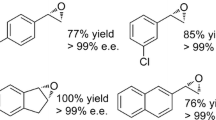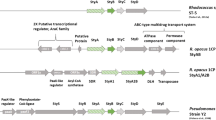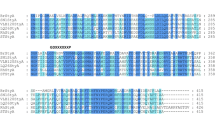Abstract
Styrene monooxygenase (StyA, SMOA)- and flavin oxidoreductase (StyB, SMOB)-coding genes of styrene-assimilating bacteria Rhodococcus sp. ST-5 and ST-10 were successfully expressed in Escherichia coli. Determined amino acid sequences of StyAs and StyBs of ST-5 and ST-10 showed more similarity with those of Pseudomonas than with self-sufficient styrene monooxygenase (StyA2B) of Rhodococcus. Recombinant enzymes were purified from E. coli cells as functional proteins, and their properties were characterized in detail. StyBs (flavin oxidoreductase) of strains ST-5 and ST-10 have similar enzymatic properties to those of Pseudomonas, but StyB of strain ST-10 exhibited higher temperature stability than that of strain ST-5. StyAs of strains ST-5 and ST-10 catalyzed the epoxidation of vinyl side-chain of styrene and its derivatives and produced (S)-epoxides from styrene derivatives and showed high stereoselectivity. Both StyAs showed higher specific activity on halogenated styrene derivatives than on styrene itself. Additionally, the enzymes could catalyze the epoxidation of short-chain 1-alkenes to the corresponding (S)-epoxides. Aromatic compounds including styrene, 3-chlorostyrene, styrene oxide, and benzene exhibited marked inhibition of SMO reaction, although linear 1-alkene showed no inhibition of SMO activity at any concentration.






Similar content being viewed by others
References
Beltrametti F, Marconi AM, Bestetti G, Colombo C, Galli E, Ruzzi M, Zennaro E (1997) Sequencing and functional analysis of styrene catabolism genes from Pseudomonas fluorescens ST. Appl Environ Microbiol 63:2232–2239
Champreda V, Choi YJ, Zhou NY, Leak DJ (2006) Alternation of the stereo- and regioselectivity of alkene monooxygenase based on coupling protein interaction. Appl Microbiol Biotechnol 71:840–847
Collman JP, Wang Z, Straumanis A, Quelquejeu M (1999) An efficient catalyst for asymmetric epoxidation of terminal olefins. J Am Chem Soc 121:460–461
Eppink MHM, Schreuder HA, van Berkel WJH (1997) Identification of a novel conserved sequence motif in flavoprotein hydroxylases with a putative dual function in FAD/NAD(P)H binding. Protein Sci 6:2454–2458
Eulberg D, Golovleva LA, Schlömann M (1997) Characterization of catechol catabolic genes from Rhodococcus erythropolis 1CP. J Bacteriol 179:370–381
Farinas ET, Alcalde M, Arnold F (2004) Alkene epoxidation catalyzed by cytochrome P450 BM-3 139-3. Tetrahedron 60:525–528
Gennaro PD, Colmegna A, Galli E, Sello G, Pelizzoni F, Bestetti G (1999) A new biocatalyst for production of optically pure aryl epoxides by styrene monooxygenase from Pseudomonas fluorescens ST. Appl Environ Microbiol 65:2794–2797
Groves JT, Myers RS (1983) Catalytic asymmetric epoxidations with chiral iron porphyrins. J Am Chem Soc 105:5791–5796
Habets-Crützen AQH, Brink LES, van Ginkel CG, de Bont JAM, Tramper J (1984) Production of epoxides from gaseous alkenes by resting-cell suspensions and immobilized cells of alkene-utilizing bacteria. Appl Microbiol Biotechnol 20:245–250
Hartmans S, Weber FJ, Somhorst DPM, de Bont JAM (1991) Alkene monooxygenase from Mycobacterium: a multicomponent enzyme. J Gen Microbiol 137:2555–2560
Hofstetter K, Lutz J, Lang I, Witholt B, Schmid A (2004) Coupling of biocatalytic asymmetric epoxidation with NADH regeneration in organic-aqueous emulsions. Angew Chem Int Ed 43:2163–2166
Hollmann F, Lin PC, Witholt B, Schmid A (2003) Stereospecific biocatalytic epoxidation: the first example of direct regeneration of a FAD-dependent monooxygenase for catalysis. J Am Chem Soc 125:8209–8217
Iida H, Maruyama T, Kobayashi H, Kakidani H (2005) Selective oxidation of organic compounds by utilizing toluene monooxygenases. TOSOH Res Technol Rev 49:3–13
Itoh N, Yoshida K, Okada K (1996) Isolation and identification of styrene-degrading Corynebacterium strains, and their styrene metabolism. Biosci Biotech Biochem 60:1826–1830
Kantz A, Chin F, Nallamothu N, Nguyen T, Gassner GT (2005) Mechanism of flavin transfer and oxygen activation by the two-component flavoenzyme styrene monooxygenase. Arch Biochem Biophys 442:102–116
Lee JK, Zhao H (2007) Identification and characterization of the flavin: NADH reductase (PrnF) involved in a novel two-component arylamine oxygenase. J Bacteriol 189:8556–8563
Marconi AM, Beltrametti F, Bestetti G, Solinas F, Ruzzi M, Galli E, Zennaro E (1996) Cloning and characterization of styrene catabolism genes from Pseudomonas fluorescens ST. Appl Environ Microbiol 62:121–127
McClay K, Fox BG, Steffan RJ (2000) Toluene monooxygenase-catalyzed epoxidation of alkenes. Appl Environ Microbiol 66:1877–1882
McLeod MP, Warren RL, Hsiao WW, Araki N, Myhre M, Fernandes C, Miyazawa D, Wong W, Lillquist AL, Wang D, Dosanjh M, Hara H, Petrescu A, Morin RD, Yang G, Stott JM, Schein JE, Shin H, Smailus D, Siddiqui AS, Marra MA, Jones SJ, Holt R, Brinkman FS, Miyauchi K, Fukuda M, Davies JE, Mohn WW, Eltis LD (2006) The complete genome of Rhodococcus sp. RHA1 provides insights into a catabolic powerhouse. Proc Natl Acad Sci U S A 103:15582–15587
O'Connor KE, Dobson AD, Hartmans S (1997) Indigo formation by microorganisms expressing styrene monooxygenase activity. Appl Environ Microbiol 63:4287–4291
Otto K, Hofstetter K, Röthlisberger M, Witholt B, Schmid A (2004) Biochemical characterization of StyAB from Pseudomonas sp. strain VLB120 as a two-component flavin-diffusible monooxygenase. J Bacteriol 186:5292–5302
Panke S, Witholt B, Schmid A, Wubbolts MG (1998) Towards a biocatalyst for (S)-styrene oxide production: characterization of the styrene degradation pathway of Pseudomonas sp. strain VLB120. Appl Environ Microbiol 64:2032–2043
Panke S, de Lorenzo V, Kaiser A, Witholt B, Wubbolts MG (1999) Engineering of a stable whole-cell biocatalyst capable of (S)-styrene oxide formation for continuous two-liquid-phase applications. Appl Environ Microbiol 65:5619–5623
Parry RJ, Li W (1997) An NADPH: FAD oxidoreductase from the valanimycin producer, Streptomyces viridifaciens. J Biol Chem 272:23303–23311
Schmid A, Hofstetter K, Feiten HJ, Hollmann F, Witholt B (2001) Integrated biocatalytic synthesis on gram scale: the highly enantioselective preparation of chiral oxiranes with styrene monooxygenase. Adv Synth Catal 343:732–737
Shi Y (2004) Organocatalytic asymmetric epoxidation of olefins by chiral ketones. Acc Chem Res 37:488–496
Small FJ, Ensign SA (1997) Alkene monooxygenase from Xanthobacter strain Py2. J Biol Chem 272:24913–24920
Smith SW (2009) Chiral toxicology: it’s the same thing … only different. Toxicol Sci 110:4–30
Takeo M, Yasukawa T, Abe Y, Niihara S, Maeda Y, Negoro S (2003) Cloning and characterization of a 4-nitrophenol hydroxylase gene cluster from Rhodococcus sp. PN1. J Biosci Bioeng 95:139–145
Takeo M, Murakami M, Niihara S, Yamamoto K, Nishimura M, Kato D, Negoro S (2008) Mechanism of 4-nitrophenol oxidation in Rhodococcus sp. strain PN1: characterization of the two-component 4-nitrophenol hydroxylase and regulation of its expression. J Bacteriol 190:7367–7374
Tischler D, Eulberg D, Lakner S, Kaschabek SR, van Berkel WJH, Schlömann M (2009) Identification of a novel self-sufficient styrene monooxygenase from Rhodococcus opacus 1CP. J Bacteriol 191:4996–5009
Toda H, Itoh N (2012) Isolation and characterization of styrene metabolism genes from styrene-assimilating soil bacteria Rhodococcus sp. ST-5 and ST-10. J Biosci Bioeng 113:12–19
Vallon O (2000) New sequence motifs in flavoproteins: evidence for common ancestry and tools to predict structure. Proteins 38:95–114
Van Berkel WJH, Kamerbeek NM, Fraaije MW (2006) Flavoprotein monooxygenases, a diverse class of oxidative biocatalysts. J Biotechnol 124:670–689
Van Hellemond EW, Janssen DB, Fraaije MW (2007) Discovery of a novel styrene monooxygenase originating from the metagenome. Appl Environ Microbiol 73:5832–5839
Velasco A, Alonso S, García JL, Perera J, Díaz E (1998) Genetic and functional analysis of the styrene catabolic cluster of Pseudomonas sp. strain Y2. J Bacteriol 180:1063–1071
Yeo YJ, Shin S, Lee SG, Park S, Jeong YJ (2009) Production, purification, and characterization of soluble NADH-flavin oxidoreductase (StyB) from Pseudomonas putida SN1. J Microbiol Biotechnol 19:362–367
Zhang W, Jacobsen EN (1991) Asymmetric olefin epoxidation with sodium hypochlorite catalyzed by easily prepared chiral Mn(III) salen complex. J Org Chem 56:2296–2298
Author information
Authors and Affiliations
Corresponding author
Rights and permissions
About this article
Cite this article
Toda, H., Imae, R., Komio, T. et al. Expression and characterization of styrene monooxygenases of Rhodococcus sp. ST-5 and ST-10 for synthesizing enantiopure (S)-epoxides. Appl Microbiol Biotechnol 96, 407–418 (2012). https://doi.org/10.1007/s00253-011-3849-3
Received:
Revised:
Accepted:
Published:
Issue Date:
DOI: https://doi.org/10.1007/s00253-011-3849-3




